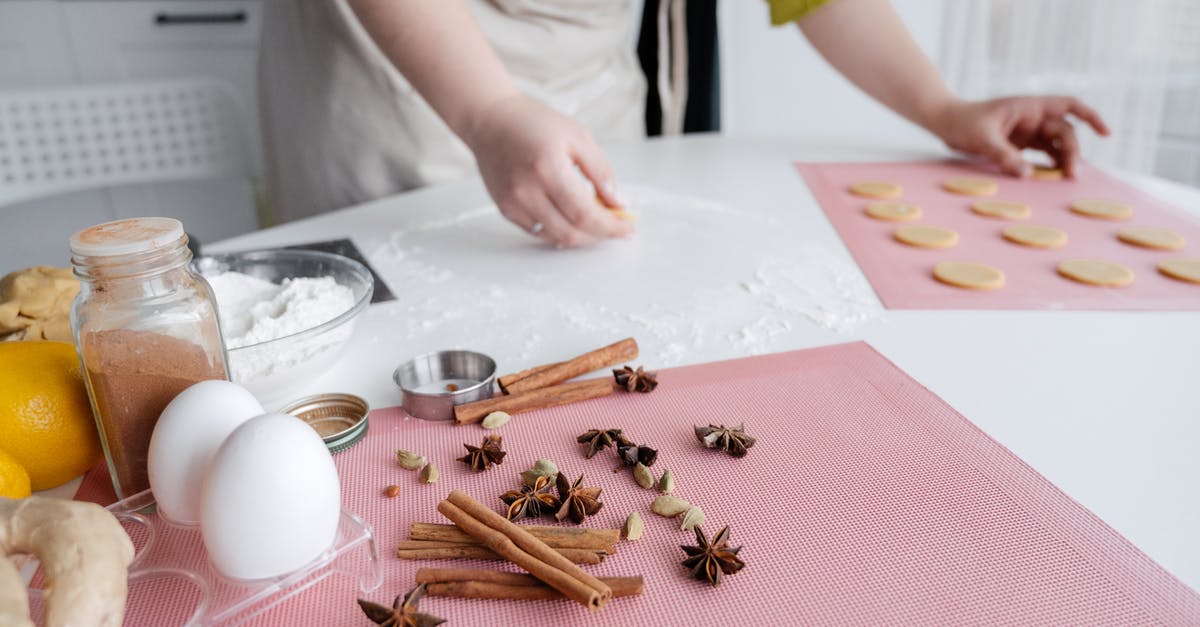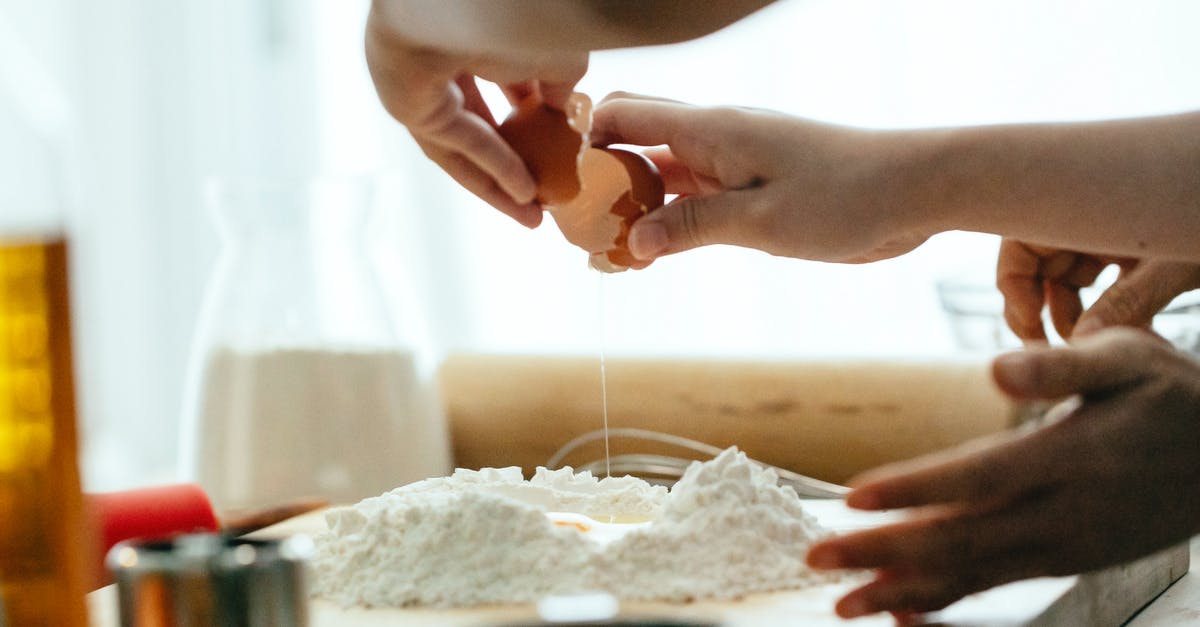Does egg make the cookies rise(puffy)?

I want to make chocolate chip cookies that are chewy and thin (spread out).
I followed the recipe here however I reduced everything by half.
The result was not impressive at all. It's nothing like what you see on the website - it's thick and has a dome-like shape, not thin and spread out and without cracks.
I added more milk in hopes it might help make the cookies spread more but it still didn't.
I tried to use only egg yolk instead of the whole egg but the problem still persist.
What did I do wrong??
These are my guesses:
- Over-creaming process? but it's melted butter (and melted butter is supposed to spread, doesn't it?)
- Egg? Do eggs leaven the cookies?
- Baking soda? Does it make the cookies puffy?
Also, how do I make them flat and have cracks on the top?
Best Answer
The texture of cookies is a complex interaction of many factors, including the size of the cookie, the temperature of the oven, the amount of leavening, the way the fat is treated, and so on.
The flat, thin cookie with the cracks on top that you describe and desire is achieved by slightly under-baking the cookies, allowing them to rise, and then taking them out of the oven. They then cool and deflate, causing the "cracks" and thinness.
The most likely culprit is that you are over-baking your cookies, and they are setting in the oven while fully domed up. They would be fine cookies, but more of a crispy style.
A secondary, and related, contributing factor would be having the oven temperature too high. If you don't already have one, an oven thermometer is an inexpensive and helpful investment to make sure you are baking at the desired temperature, as many ovens are off by a fair margin.
Note also that these are quite large cookies, baked with a "large" scoop, only six per tray. That helps achieve the fallen state. Don't make your cookies too small, if you are looking for this texture.
To answer your sub-questions:
- Creaming cannot apply to a melted butter cookie, as it requires a solid but plastic fat to incorporate air into the cookie
- The egg contributes structure (from protein), tenderness, and usually a fairly considerable proportion of the overall water in the cookie dough
- In this recipe, the baking soda is primarily present to promote browning, as there is very little acid for it to react with other than from the molasses in the brown sugar (it will leaven a little). Since these are "fallen" cookies, it is harder to get good browning and therefore flavor development. The soda is to promote that.
Pictures about "Does egg make the cookies rise(puffy)?"



Do eggs Help cookies rise?
Beaten egg whites can be gently incorporated into a batter or soft dough to make it rise; while egg yolks can add richness, color, and flavor. In addition, lightly beaten eggs, either whole or separated can be brushed on the surface of breads, cookies, and biscuits to give them a pretty shine.What causes cookies to be puffy?
Q: Why are my cookies so puffy and cakey? Whipping too much air into the dough. That fluffy texture you want in a cake results from beating a lot of air into the room temperature butter and sugar, and it does the same for cookies. So don't overdo it when you're creaming together the butter and sugar.What happens when you add an egg to a cookie recipe?
Life Made Sweet explains that before the dough even gets baked, the egg is already altering its structure by shortening the gluten strands in it. The egg also acts as an emulsifier, lending itself to creamier dough that's tender when baked.What helps cookies puff up when baking?
(Exactly) How to Make Fluffy Cookies: 11 Genius Tips for Puffy...10 Most Common Cookie Baking Mistakes
More answers regarding does egg make the cookies rise(puffy)?
Answer 2
To promote spread in cookies, you want to have a fat with a low melting point and an alkaline dough. In general, butter has the lowest melting point of commonly used cookie fats, followed by non-hydrogenated shortenings; hydrogenated shortenings have the highest melting point. The low melting point allows the fat to melt and let the cookie spread before the starch gelatinizes.
An alkaline dough comes from the egg whites and using baking soda. Yolks and baking powder are both acidic and will make the dough tighter, leading to a cookie that rises more than it spreads. (The yolks won't cause much of a problem, they generally react with your baking soda to leaven the cookie. Definitely avoid baking powder if you want a cookie to spread though.)
The type of flour used can also change how your cookie bakes. A starchier flour like cake flour will lead to a taller and cakier cookie. A higher protein flour like AP or bread flour will lead to a cookie with more spread.
Finally, you don't want to add liquids like milk to most cookies. Fats and eggs won't activate the gluten in your flour, but liquids that are more watery will cause gluten development to begin. Gluten will make it harder for the cookies to spread.
As for the cracked tops, I agree with SAJ14SAJ. This is caused by the cookies falling, which can be either from being removed from the oven before the dough has set or from slightly over-leavening the cookie.
Answer 3
That's actually very easy, first you want to increase the amount of white sugar, your balance should be about equal amounts of butter, white sugar and brown sugar; for taller cookies reduce the white sugar by a little, using about 3/4 of what your recipe calls for; for flatter, crispier you increase the proportion of the white sugar a little. Eg: 1 cup butter, 1c white and 1c brown equals a standard cookie; while 1c butter, 1.25c white and 1c brown gives thinner and therefore crispier; finally 1c butter, .75c white and 1c brown will give you a cookie that spreads less. Btw, add your eggs to the butter sugar mix after its been creamed and in my 50+ yrs of experience I've never found a really good cookie recipe that uses melted butter that just separates it, not conducive to blending well, just leave the butter out overnight if you want it very soft.
Answer 4
I agree with the above comments.
My thoughts are that you will find halving cookie recipes give a less than desirable outcome on some recipes. So I avoid it per my trials and errors.
Another is that more than 2 eggs and adding yolks make cookies thick, puffy and cake-like, hense the reason why cakes have so many eggs in their recipes. Egg whites helps with crispiness.
Adding milk gave more moisture than the eggs already had and made them even more puffy.
Chilling the dough gives puffy cookies.
Baking soda gives a rise and spread effect. Its needed in cookies. Baking powder causes puffy soft cookies and isn't needed unless you want that puffiness.
1/4 teaspoon per one cup of flour is the ratio.
Added sugars contribute to browning, not just baking soda.
Melted butter gives chewy cookies. However if not melted properly you will get puffy cookies. Google how to make "browned butter" for chocolate chip cookies and that should help. Otherwise, unwrap your sticks of butter, slice them, spread them out on a plate and leave them on the counter 30 minutes. That will give you room temp butter for cookie recipes. Also when creaming butter and sugars you should do so by going from grainy texture to creamy texture (no graininess).
After you add the eggs and vanilla to the butter and sugar mixture, you mix until its light "in color" or pale yellow and its fluffy in texture. This shouldnt take long to achieve with a stand mixer. Next, only mix in the flour and chips 45 seconds to 1 minute on low speed to avoid gluten development causing puffy cookies. You can finish mixing with a spatula or clean hands depending on how much dough you have.
One last tip: using 1/2 teaspoon of cream of tarter to the dry ingredients will flatten your cookies, give a crackled look, crisp edge and chewy centers. Much like a snickerdoodle and it wont effect the taste. Good luck.
Sources: Stack Exchange - This article follows the attribution requirements of Stack Exchange and is licensed under CC BY-SA 3.0.
Images: SHVETS production, Klaus Nielsen, Katerina Holmes, Katerina Holmes
